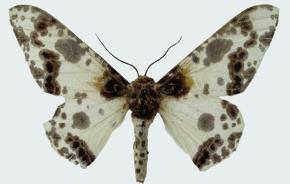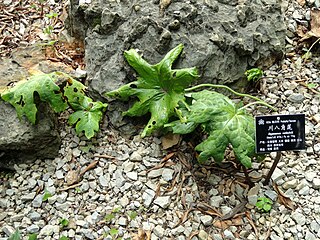
Adenophora is a genus of flowering plants in the family Campanulaceae, the bellflowers. Plants of this genus are known commonly as ladybells. Most are native to eastern Asia, with a few in Europe. Many are endemic to either China or Siberia.

Notocelia rosaecolana is a moth of the family Tortricidae. It is found in the Palearctic realm, where it has been recorded from China, Mongolia, Korea, Japan, Iran, Central Asia, Russia and Europe.

Udea prunalis is a moth of the family Crambidae. It is found in Europe and China. The species was first described by Michael Denis and Ignaz Schiffermüller in 1775. In the Butterfly Conservation's Microlepidoptera Report 2011 this species was classified as common in the UK.

Gravitarmata margarotana, the pine cone tortrix or pine twig moth, is a moth of the family Tortricidae. In Europe, it is found from England to Austria and Poland, east to the Baltic region to Russia, China, Korea and Japan.

Rhopobota naevana, the holly tortrix moth, holly leaf tier or blackheaded fireworm, is a moth of the family Tortricidae. It is found from Europe to eastern Russia, China, Taiwan, Mongolia, Korea and Japan. It is also present in India, Sri Lanka and North America.

Biston suppressaria, the tea looper, is a moth of the family Geometridae. It is found in China, India, Myanmar, Nepal, and Sri Lanka.

Biston panterinaria is a moth of the family Geometridae. It is found in China, India, Nepal, Sikkim, Vietnam and Thailand.

Dysosma is a group of herbaceous perennials in the Berberidaceae or barberry family described as a genus in 1928. It is native to China and Indochina.
Helcystogramma bicuneum is a moth in the family Gelechiidae. It was described by Edward Meyrick in 1911. It is known from north-eastern India and China.

Gynnidomorpha alismana, the water plantain conch, is a moth of the family Tortricidae. It was described by Ragonot in 1883. It is found in most of Europe, except Spain, Switzerland, most of the Balkan Peninsula and Ukraine. Further east it is found across the Palearctic to China and Korea. It is found in riverine and other watery habitats.

Spilosoma rubidus is a moth in the family Erebidae. It was described by John Henry Leech in 1890. It is found in China and Taiwan.
Auzata chinensis is a moth in the family Drepanidae. It was described by John Henry Leech in 1898. It is found in the Chinese provinces of Hunan, Sichuan, Zhejiang and Shaanxi.
Pseudalbara parvula is a moth in the family Drepanidae. It was described by John Henry Leech in 1890. It is found in China, south-eastern Russia and Japan.
Tridrepana rubromarginata is a moth in the family Drepanidae. It was described by John Henry Leech in 1898. It is found in China, India, Bhutan and Nepal.
Habrosyne violacea is a moth in the family Drepanidae. It is found in the Russian Far East, Korea, China, Myanmar, Vietnam, Nepal and Sikkim, India.
Macrothyatira conspicua is a moth in the family Drepanidae first described by John Henry Leech in 1900. It is found in the Chinese provinces of Shaanxi, Zhejiang, Hunan, Fujian, Sichuan and Yunnan and in Taiwan.
Nothoploca nigripunctata is a moth in the family Drepanidae. It is found in India, Vietnam, Korea, China and the Russian Far East.
Tethea ampliata is a moth in the family Drepanidae. It is found in the Russian Far East, Korea, Japan, Taiwan and northern and north-eastern China.
Parapsestis lichenea is a moth in the family Drepanidae. It was described by George Hampson in 1893. It is found in Sikkim in India, Myanmar, Thailand, Vietnam and the Chinese provinces of Henan, Shaanxi, Zhejiang, Hubei, Fujian, Sichuan, Yunnan and Tibet.
Acria ceramitis is a moth in the family Depressariidae. It was described by Edward Meyrick in 1908. It is found in China, southern India, Assam, Korea and Japan.








